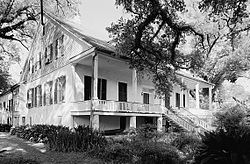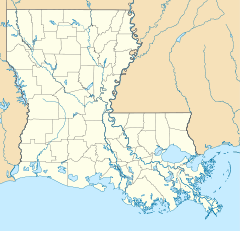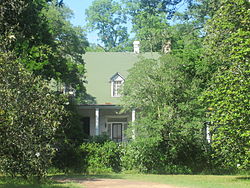- Magnolia Plantation (Derry, Louisiana)
-
For other uses, see Magnolia Plantation.Magnolia Plantation
 Magnolia Plantation
Magnolia PlantationNearest city: Derry, Louisiana Coordinates: 31°32′59″N 92°56′26″W / 31.54972°N 92.94056°WCoordinates: 31°32′59″N 92°56′26″W / 31.54972°N 92.94056°W Built: 1840 Architectural style: Acadian Cottage Governing body: Private NRHP Reference#: 79001071[1] Significant dates Added to NRHP: March 07, 1979 Designated NHL: January 3, 2001[2] Shown here Hidden by trees is Magnolia Plantation, located in the Cane River Creole National Historical Park in south Natchitoches Parish.
Magnolia Plantation is a former plantation in Natchitoches Parish, Louisiana. The site was declared a National Historic Landmark in 2001.[2][3] Included in the Cane River Creole National Historical Park, Magnolia Plantation is also a destination on the Louisiana African American Heritage Trail.
Contents
History
The plantation traces its roots back to Jean Baptiste LeComte II, who received French and Spanish land grants in the mid-18th century. This began the plantation's recorded history, although the first structures were not built until the 19th century, and the plantation was not operating until 1830. Ambrose LeComte, son of Jean Baptiste, married Julia Buard. They began a tradition of community and cultivation on a vast piece of property. Their two daughters, Laura and Ursula Atala, married two sons from the Hertzog family: Bernard Theophile Henry and Matthew Hertzog, respectively. Atala and Matthew Hertzog took over the plantation shortly after their marriage in 1852, thus linking the Hertzog name to Magnolia.
Magnolia Plantation is exceptional because of the surviving farming technology, such as the cotton picker tractors and two cotton gins (both steam- and animal-powered). It has 21 buildings that contribute to the significance of the site, an unusually high number for surviving plantations. Among these are the eight quarters, rare brick cabins used by workers who lived and worked on the plantation for 100 years after the American Civil War.
The plantation was also exceptional for its influence in the community and the Cane River area. La Côte Joyeuse became home to many, including the writer Francois Mignon. He claimed to have come to visit Magnolia on Cane River for a week and stayed 60 years. For 100 years after the American Civil War, "the Hertzogs," as the place was familiarly known, served as the center of a community of Creoles of color and blacks who lived and worked on the plantation as tenant farmers and laborers.[4] By the mid-20th century, changes in agriculture led people to urban jobs.
Today
The park portion of the plantation is owned by the National Park Service. The main house and the farming acreage is owned by the Descendants of Ambrose John Hertzog and Sarah Jane Hunter Hertzog. The Park Service has acquired 16 buildings, including the Plantation Store, the cotton gin, the Overseer's House (or Slave Hospital); blacksmith shop and the brick quarters. It continues to improve their condition to preserve them for future generations.
The Cane River Creole National Historical Park is located at 5487 Louisiana Highway 119. The closest town is Derry, Louisiana. The park is open from Mondays to Fridays, from 8 am to 4:30 pm. For more information about the plantation and tours, the following address may be contacted:
Curation Facility
400 Rapides Dr.
Natchitoches, Louisiana
71457
(318) 352-0383In popular culture
- Reportedly haunted by spirits of residents of the main house and of slaves who practiced Voodoo, Magnolia Plantation has been featured on the Travel Channel series Ghost Adventures.
- Scariest Places on Earth sent two families to spend the night here.
References
- ^ "National Register Information System". National Register of Historic Places. National Park Service. 2009-03-13. http://nrhp.focus.nps.gov/natreg/docs/All_Data.html.
- ^ a b "Magnolia Plantation". National Historic Landmark summary listing. National Park Service. http://tps.cr.nps.gov/nhl/detail.cfm?ResourceId=-1953832489&ResourceType=District. Retrieved 2008-01-30.
- ^ Jonathan Fricker, Donna Fricker and Patty Henry (November, 1999). National Historic Landmark Nomination: Magnolia PlantationPDF (307 KB). National Park Service
- ^ Muriel (Miki) Crespi, "A Brief Ethnography of Magnolia Plantation", National Park Service, accessed 9 JUl 2008
External links
- Cane River National Heritage Area, a National Park Service Discover Our Shared Heritage Travel Itinerary
- Muriel (Miki) Crespi, "A Brief Ethnography of Magnolia Plantation", National Park Service
5. MAGNOLIA PLANTATION: A FAMILY FARM, by Henley Alexander Hunter, Northwestern State University Press, 2005.
U.S. National Register of Historic Places Topics Lists by states Alabama • Alaska • Arizona • Arkansas • California • Colorado • Connecticut • Delaware • Florida • Georgia • Hawaii • Idaho • Illinois • Indiana • Iowa • Kansas • Kentucky • Louisiana • Maine • Maryland • Massachusetts • Michigan • Minnesota • Mississippi • Missouri • Montana • Nebraska • Nevada • New Hampshire • New Jersey • New Mexico • New York • North Carolina • North Dakota • Ohio • Oklahoma • Oregon • Pennsylvania • Rhode Island • South Carolina • South Dakota • Tennessee • Texas • Utah • Vermont • Virginia • Washington • West Virginia • Wisconsin • WyomingLists by territories Lists by associated states Other  Category:National Register of Historic Places •
Category:National Register of Historic Places •  Portal:National Register of Historic PlacesCategories:
Portal:National Register of Historic PlacesCategories:- National Historic Landmarks in Louisiana
- Louisiana African American Heritage Trail
- Houses completed in 1840
- Plantations in Louisiana
- Historic house museums in Louisiana
- Museums in Natchitoches Parish, Louisiana
- Reportedly haunted locations in the United States
Wikimedia Foundation. 2010.



